This article's lead section may be too short to adequately summarize the key points.(September 2021) |
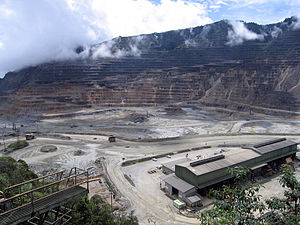

Mining in Papua New Guinea is an important part of the Papua New Guinea economy.
This article's lead section may be too short to adequately summarize the key points.(September 2021) |


Mining in Papua New Guinea is an important part of the Papua New Guinea economy.
| | This section needs expansion. You can help by adding to it. (September 2010) |
Up until 1970, there was little mineral extraction in Papua New Guinea. Since the 1970s, mineral extraction has dominated the national economy. [1]
With the exception of the Ok Tedy Mine (copper-gold) and the Ramu nickel-cobalt mine, almost all of the mining in PNG has been gold mining. The two largest gold mines are the Porgera (Enga Province) and Lihir (New Ireland Province) mines. In 2009, the Hidden Valley gold and silver mine (Morobe Province) commenced production.
All the mining activity that has taken place in the country since 1970 has produced approximately 5 million tonnes of copper between 1970 and 2007. The country produced 202,277 t of copper in 2003 compared to 211,315 in 2002, all of which was produced by the Ok Tedi Mine the most active mine in the country. The mine reported that 29.32 Mt of ore was mined (approximately 240,000 t/d material moved) and 29.26 Mt milled (77,000 t/d) with a head grade of 0.78% Cu and 0.8 g/t Au. Respective gold and copper recoveries for 2003 at Ok Tedy were 68% and 84%.
| | This section needs expansion. You can help by adding to it. (January 2011) |

Edie Creek has been a historic gold and silver mining area since its discovery in 1926. [2] Located about 5 km south-west of Wau, it was the centre of one of the first major gold rushes in PNG before World War II. [2] Large amounts of gold have been extracted by both alluvial and underground mining. [2] Brothers William and Stanley Royal found gold at Edie Creek in 1926. On 16 July 1951, a QANTAS Drover aircraft crashed into the sea near Lae carrying gold belonging to the Bulolo Gold Dedging Company. It is believed that 35,000 pounds worth of gold bullion was on board. It was recovered later by special divers. The remains can be seen here.
The Frieda River Project is situated on the border of Sandaun and East Sepik Provinces on a tributary of the Sepik River.
Hidden Valley is an open-pit, gold-silver mine and processing plant in Morobe Province. [3] The mine is approximately 210 km north-north-west of Port Moresby, and 90 km south-southwest of Lae. [3] It is operated by Morobe Mining Joint Ventures, a 50:50 joint venture between Harmony, a company that operates primarily in South Africa, and Newcrest Mining, an Australian gold and copper mining company. [3] The metals are epithermal deposits from hydrothermal systems related to volcanic activity. [4]
Construction of the Kainantu Gold Mine began in March 2004 and commenced operations in March 2006. In 2004 Landowners threatened to close down Highlands Pacific's Kainantu gold mine. [5] Kainantu Gold Mine is an underground mine and the concentrate is trucked to Lae and shipped to Japan for processing. In January 2009 production was halted. The mine has been designed to produce in excess of 100,000 ounces of gold per year. In 2007, a decision was made by Highlands Pacific Ltd. to sell Kuinantu Gold mine and licences to Placer Dome Oceania, a subsidiary of Barrick Gold Corporation for a cash price of US$141.5 million. [6] [7] [8] The mine is now owned and operated by K92 mining, a Canadian company.[ citation needed ]
Lihir is an open cut gold mine operating on Lihir Island in the Bismarck Archipelago. It is wholly owned by Newcrest Mining.
The company, incorporated in Papua New Guinea in June 1995, and named Lihir as its first project was to raise capital to build the Lihir Island gold mine was merged with Newcrest Mining at the end of August 2010 (the last day for trading of Lihir Gold shares was August 30, 2010). [9] Australian economist Ross Garnaut served as Lihir's chairman from 1995 to 2010. [10] [11]
Merger talks were first made known in April 2010, with an announcement by Newcrest Mining. On Monday August 23, 2010 the A$9.5 billion takeover offer by Newcrest Mining was approved after 99.86% of Lihir Gold Shareholders voted in favour of it. [12] The takeover received national court of Papua New Guinea approval on August 28, 2010. [13]
The acquisition made Newcrest Mining the world's fifth-largest gold producer with a production of 2.8 million ounces of gold (2009 combined production of the 2 companies). [14]
Misima Island is known as a mining island. A huge mine operated many years on the island. The Misima mine was a joint venture by Placer Dome Inc (owning 80%) and the state-owned Orogen Minerals Ltd. In March 2012, Barrick closed its post closure monitoring office in Bwagaoia having successfully rehabilitated the mine and mill sites.
Since 2004 when the mine closed, artisanal mining has become a major source of income in the island, with an association Misima Alluvial Gold Mining Association (MAGMA) starting in 2007. Other sources of income, especially for people living on the north coast, are cash crops of coconuts, copra, and cacao. A commercial fisheries project has been proposed, but has not been developed yet.

The Ok Tedi Mine is situated at Mount Fubilan in the Star Mountains in western PNG, close to the Indonesian border. OK Tedi Mining Ltd. (OTML) is 100% Government owned (2014).
Bougainville Copper Limited (BCL) developed the Panguna mine on Bougainville Island, producing copper concentrate from 1972 until May 1989, when mining operations were suspended due to civil unrest in the province. [15] Rio Tinto is a major shareholder of the BCL (54%) and is currently reviewing its stake in the company. The deposit has a life of mine of some 20 years and has a capacity to produce 180 000t of copper and 480 000 oz gold per year. This development marked one of the first major investments in PNG, and was at one stage one of the world's largest copper - gold mines.
As of 2014, talks of restarting mining operations in Panguna mine have continued, with BCL seeking official endorsement from the Autonomous Bougainville Government and the National Government of Papua New Guinea. [16]
The Porgera Gold Mine is a large gold mining operation located in Enga province. The mine is located at the head of the Porgera Valley and end of the river and operated by Barrick Gold d.b.a. Porgera Joint Venture (PJV).
The Ramu lateritic nickel-cobalt mining project is located in the Madang Province of Papua New Guinea. The 2022 annual output was 34,302 tonnes of nickel and 2,987 tonnes of cobalt contained in a mixed hydroxide intermediate product. [17] [18]
The project comprises the Kurumbukari mine site and beneficiation plant, and a 135 kilometres (84 mi) slurry pipeline from the mine to the Basamuk processing plant. The mine is located on the Kurumbukari plateau, on the southern side of the Ramu River Valley, 75 kilometres (47 mi) to the southwest of Madang. The processing plant site is located on the coast of Basamuk Bay, 55 kilometres (34 mi) to the southeast of Madang. [17]
Discovered in 1962 by the Australian Bureau of Mineral Resources, the Kurumbakari project was explored intermittently by several companies. By the 1990s, Highlands Pacific Limited completed detailed exploration followed by a feasibility study. In 2005, China Metallurgical Group Corporation (“MCC”) acquired the majority interest in the Project and Ramu NiCo Management (MCC) Limited became Manager and Operator for the Ramu Nickel Joint Venture. The mine project was commissioned in 2012 and achieved design capacity in 2017. [17] [18]
Allied Gold, an Australian-based company, operate an open pit gold (and silver) mine called the Simberi Oxide Gold Project in the volcanic highlands on the eastern side of Simberi Island [19] Gold production started in February 2008 and the mine has a projected life of 8 years. [19] Production for the 2008 calendar year was 75,267 ounces (2,133,787 grams). [19]
| | This section needs expansion. You can help by adding to it. (September 2010) |
3°47′20″S152°05′38″E / 3.789°S 152.094°E [20]
The Solwara 1 Project is located at 1600 metres water depth in the Bismarck Sea, New Ireland Province. [21] It will be the world's first deep sea mining project, with first production expected in 2013. [21] [22] The resource is high grade copper-gold resource and the world's first Seafloor Massive Sulphide (SMS) resource. [21] Important minerals are created by the rapid cooling of the gases emerging from volcanic openings on the sea floor. [23] In 2014 a 20-year mining license was granted to a Canadian company. [24]
| | This section needs expansion. You can help by adding to it. (September 2010) |
A mine in Mline bay province. [25]
Increased mining in Papua New Guinea has caused notable environmental impacts. Papua New Guinea has permitted the direct discharge of tailings to its rivers and seas for decades. [26]
After the construction of an open-cut gold mine and an ore-processing facility on Misima Island in 1988, large increases of sedimentation caused a decrease in tissue-layer thickness of a nearby coral reef. [27] Mining in the Ok Tedi Mine also increased sedimentation in the Ok Tedi River by 5-10 times. The poisonous waste reaches the Fly River where it kills fish and trees, and poisons croplands and drinking water. [28] Increased sediment load in the river has caused high concentrations of dissolved copper in the inner floodplain. [29]
Papua New Guinea has large reserves of minerals and gas. The mineral exports are gold, silver, copper, nickel, and cobalt. According to the Bank of Papua New Guinea's Quarterly Economic Bulletin, the weighted average kina price of Papua New Guinea's export commodities (excluding LNG) increased by 20.7% in September 2021, compared to an increase of 2.5% in the corresponding quarter of 2020. There was an increase of 16% in the weighted average price of mineral exports, compared to an increase of 8.2% in the corresponding quarter of 2020. [30]

The economy of Papua New Guinea (PNG) is largely underdeveloped with the vast majority of the population living below the poverty line. However, according to the Asian Development Bank its GDP is expected to grow 3.4% in 2022 and 4.6% in 2023. It is dominated by the agricultural, forestry, and fishing sector and the minerals and energy extraction sector. The agricultural, forestry, and fishing sector accounts for most of the labour force of PNG while the minerals and energy extraction sector, including gold, copper, oil and natural gas is responsible for most of the export earnings.
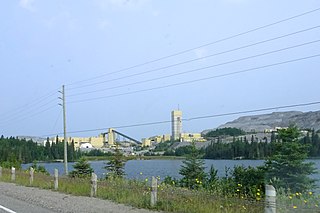
Barrick Gold Corporation is a mining company that produces gold and copper with 16 operating sites in 13 countries. It is headquartered in Toronto, Ontario, Canada. It has mining operations in Argentina, Canada, Chile, Côte d'Ivoire, Democratic Republic of the Congo, Dominican Republic, Mali, Papua New Guinea, Saudi Arabia, Tanzania, the United States and Zambia. In 2019, it produced 5.5 million ounces of gold at all-in sustaining costs of $894/ounce and 432 million pounds of copper at all-in sustaining costs of $2.52/pound. As of 31 December 2019, the company had 71 million ounces of proven and probable gold reserves.
Kainantu is a town in the Eastern Highlands of Papua New Guinea. It had some historical significance as an airstrip town during WWII. It functions primarily as a market town for local produce growers and cash croppers. It is located on the "Highlands Highway" approximately 170 kilometres (110 mi) by road west of Lae and 90 kilometres (56 mi) by road east of Goroka. It is 11 kilometres (6.8 mi) approx from a nearby missionary station Ukarumpa and is nearby the Aiyura valley. Kainantu has basic facilities such as a school, hospital, police station, district court, and service stations.

Newcrest Mining Limited is an Australian-based corporation which engages in the exploration, development, mining and sale of gold and the froth flotation product, gold-copper concentrate. It is Australia's leading gold mining company and its operations have expanded beyond Australia, for example Indonesia, thus becoming a prominent international mining corporation. Newmont initially started the company as a subsidiary in 1966. The subsidiary became Newmont Holdings Pty Ltd in 1980 and in 1990 acquired 100 per cent of Australmin Holdings Limited taking the current name.

The Highlands Highway, sometimes known as the Okuk Highway, is the main land highway in Papua New Guinea. It connects several major cities and is vital for the movement of people and goods between the populous Highlands region and the coast.
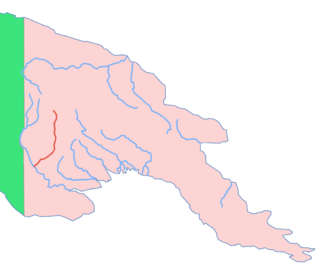
The Strickland River is a major river in the Western Province of Papua New Guinea. It is the longest and largest tributary of the Fly River with a total length of 824 km (512 mi) including the Lagaip River the farthest distance river source of the Strickland River. It was named after Edward Strickland, vice-president of the Geographical Society of Australasia by the New Guinea Exploration Expedition of 1885.
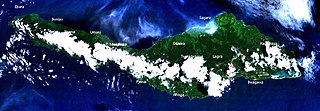
Misima is a volcanic island in the northwest of Louisiade Archipelago within Milne Bay Province of Papua New Guinea.

The Ok Tedi Mine is an open-pit copper and gold mine in Papua New Guinea located near the headwaters of the Ok Tedi River, in the Star Mountains Rural LLG of the North Fly District of the Western Province of Papua New Guinea.

Lihir Island is the largest island in the Lihir group of islands, 22 km long and 14.5 km wide, in Papua New Guinea's New Ireland Province. It consists of a complex of several overlapping basaltic stratovolcanoes rising 700 m above sea level. While the volcanoes are not currently active, geothermal activity is still present. The island is in what was the forearc basin associated with the subduction of the Pacific Plate beneath the North Bismarck Plate. Subduction stopped about 10 million years ago with the collision of the Ontong Java plateau with the subduction zone.

The Porgera Gold Mine is a large gold and silver mining operation in near Porgera, Enga province, Papua New Guinea (PNG), located at the head of the Porgera Valley. The mine is situated in the rain forest covered highlands at an altitude of 2,200 to 2,700 m, in a region of high rainfall, landslides, and frequent earthquakes.
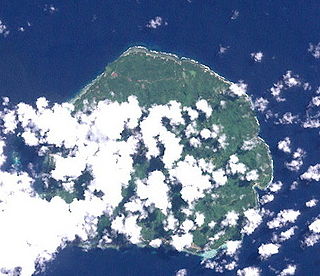
Simberi Island is a volcanic island in the Tabar Group, in Papua New Guinea's New Ireland Province.

The Ok Tedi environmental disaster caused severe harm to the environment along 1,000 km (620 mi) of the Ok Tedi River and the Fly River in the Western Province of Papua New Guinea between around 1984 and 2013. The lives of 50,000 people have been disrupted. One of the worst environmental disasters caused by humans, it is a consequence of the discharge of about two billion tons of untreated mining waste into the Ok Tedi from the Ok Tedi Mine, an open pit mine situated in the province.
Mount Fubilan was a mountain in the Western Province of Papua New Guinea. It has been removed in the course of the excavation of the Ok Tedi Mine, which been developed since 1984 as an open-pit copper and gold mine. After decades of mining, the mountain has been replaced by a massive pit in the ground.
Lihir Gold Limited was a gold mining company with operations in Papua New Guinea, Australia and West Africa.
There are different methods by which gold mining companies are ranked. One is by their annual production. Another is by their cash cost per ounce, that is, how much money it costs them to mine the gold. Since gold prices are the same everywhere, companies with lower costs per ounce make more profit. The most common method lists by market capitalization which considers the total value of capital holdings by that company. Also considered when comparing companies is their market capitalization per ounce of gold equivalent which takes the market value and total reserves and resources for each company as well as the price of gold into consideration. The figures for each company can be used to determine the value the stock market gives to each company's reserves on an ounce to ounce basis.
The Reko Diq Mine is a planned mining operation, located near Reko Diq town in Chagai District, Baluchistan, Pakistan. Reko Diq represents one of the largest copper and gold reserves in the world having estimated reserves of 5.9 billion tonnes of ore grading 0.41% copper and gold reserves amounting to 41.5 million oz, and a mining life of at least 40 years.
Mineral Resources Development Company Limited (MRDC) was established in 1975 and is 100% owned by the Government of Papua New Guinea.
The Porgera Landowners Association (PLOA) was formed in the late 1980s and incorporated in 1992. Its objectives are to represent the 10,000 landowners with traditional land around the Porgera Gold Mine and serve as a pressure group on behalf of the landowners, and to pursue landowner claims in the courts in Port Moresby. The PLOA is funded by royalties from the mine, so that the mine pays for the institution established to oppose it.
Metallurgical Corporation of China Limited is a listed company in Shanghai and Hong Kong stock exchanges. It is a subsidiary of China Metallurgical Group Corporation (MCC). In the past Baosteel Group was a minority shareholder.
Nixon Koeka Mangape is a Papua New Guinean politician. He was a member of the National Parliament of Papua New Guinea from 2012 to 2017, representing the electorate of Lagaip-Porgera Open.